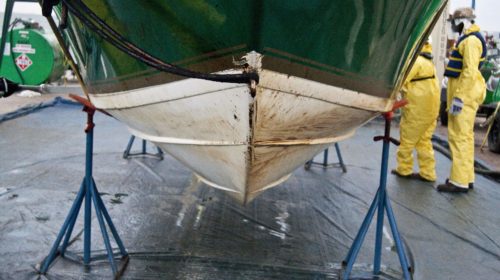
Dry ice cleaning safely removes smoke damage without timely cleanup
THE SITUATION
The historic downtown of Loveland, Ohio, is known for having a vibrant and charming town center filled with shops, restaurants and businesses. A bike trail runs through the center, making it a busy spot during the summer months, when restaurants and shops see the most business. Unfortunately, a large fire caused by an electrical issue affected several buildings in a historic block of buildings. A restaurant and catering business, a boutique and a realtor’s office were among the businesses affected. Apartments also occupied the floors above the businesses. All tenants escaped unharmed, but the fire gutted the top floors of three of the buildings and left smoke damage throughout all of the buildings. U.S. Flood Team, a contractor based in Loveland, was hired to remove the smoke damage in the upper floors of the building that was not structurally damaged.
THE PROBLEM
The U.S. Flood Team was looking for a cleaning solution that would be fast and effective. Most of the smoke damage was on the ceiling of the upper floors, which had a lot of joists, wooden geometries and electrical wires. This almost doubled the amount of square footage that would need to be cleaned, which made the cleaning more difficult and lengthier.
Another concern was completing the project without disrupting the operation of the restaurant on the lower floor. The restaurant was also operating an outdoor seating area, which was right below the cleaning project. Due to this, U.S. Flood Team wanted a solution that would leave no secondary waste and that would be environmentally responsible.
“The issue here is that there is an operating restaurant right under the rooms that we are cleaning,” said Mark Jones, President of U.S. Flood Team. “We can’t soda blast. They would not be able to have this open and operating if we used soda blasting. There would be debris everywhere. Even if we did seal up the windows, the soda could still exit the building through gaps in the façade. They’re still able to conduct business right below where we’re cleaning.”
They would typically use baking soda blasting, which uses fine sodium bicarbonate powder, but it can create a big mess, can kill surrounding vegetation and can make it more difficult to apply paint to the cleaned surfaces.
“We were looking for an alternative because of the mess created and the time spent setting up containment to ensure that the soda would not exit the building,” said Jones.
THE SOLUTION
U.S. Flood Team had previously tested dry ice cleaning before and was familiar with the process and its benefits. The contractor decided that dry ice cleaning would be the most effective cleaning solution to the challenges of this project. Cold Jet, also based in Loveland, wanted to contribute to the recovery of the downtown area and offered to donate an Aero 40 FP and all the dry ice needed for the project.
Cold Jet dry ice cleaning has become the preferred method to remove smoke soot, vaporized synthetic resins and char. It has even been known to eliminate the musty burnt smell that results from fire and smoke damage. Cold Jet provides a fast and efficient removal of smoke damage even in the tight angles of trusses and around nails, wiring and all plumbing without damage to the surface integrity.
Cold Jet’s dry ice cleaning system uses non-abrasive media in the form of recycled CO2 pellets that will not damage surfaces or equipment. The combination of dry ice cleaning’s kinetic energy and thermal effect break the connection between the dirt and surface, lifting away contaminants. Unlike blasting with other media, dry ice cleaning does not leave any secondary waste, because the dry ice particles sublimate upon impact – converting from solid to gas. Dry ice cleaning is safe and non-toxic, does not create downstream contamination and reduces or eliminates employee exposure to dangerous chemical cleaning agents.
THE RESULTS
Using the Cold Jet Aero 40 FP with the Variable Fragmenting MERN nozzle, U.S Flood Team cleaned approximately 8,000 square feet of surface in three days with a two man team.
“When you consider the time spent on the actual cleaning and the time saved by avoiding the added cleanup time, dry ice cleaning is much more efficient than alternatives,” explained Jones. “Just by avoiding the added cleanup and containment, we finished this project a lot faster. Soda takes a couple of days just to clean up.”
With dry ice cleaning, there is no secondary waste. The only thing left to clean up is the dislodged contaminant, which falls to the floor. This can be picked up quickly with a Shop-Vac.
The restaurant was fully operational during the cleaning project. If the contractor used soda blasting, the restaurant would not have been able to stay open.
U.S. Flood Team was very pleased with the results and the time saved by using dry ice cleaning.
“I like the dry ice cleaning process and the Cold Jet machine couldn’t be any more user friendly, said Jones. “It’s fast and effective and saves a lot of time on the clean up. I would absolutely use it again.”

